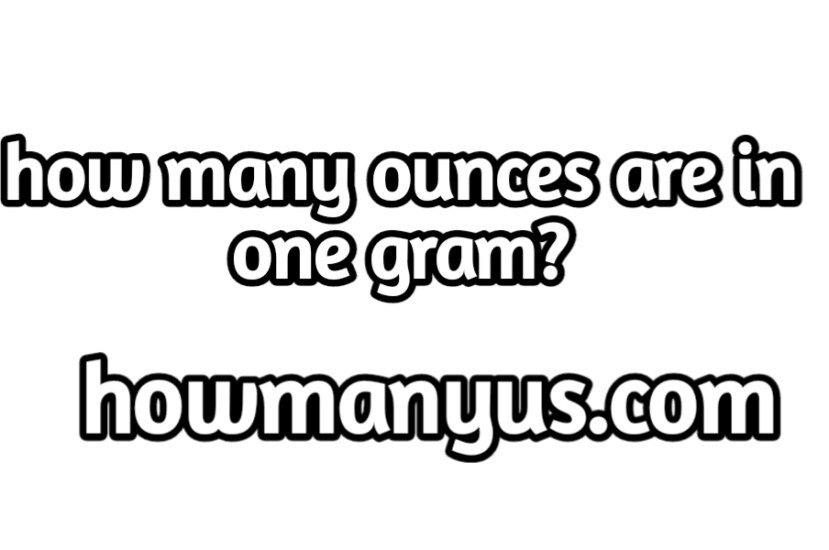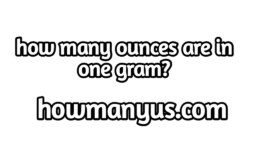Get Accurate and Quick Results with our Grams to Ounces Conversion Chart
Grams to Ounces Conversion Chart: Are you tired of struggling with converting grams to ounces? Are you constantly searching the internet for a reliable conversion chart? Look no further! Our Grams to Ounces Conversion Chart is here to make your life easier. Our chart is not only accurate, but it’s also quick and easy to use. Whether you’re a professional chef or a home cook, our chart will help you save time and ensure that your recipes turn out perfectly every time. With just a simple glance, you can convert any measurement from grams to ounces or vice versa. Say goodbye to the frustration of inaccurate measurements and hello to the convenience of our Grams to Ounces Conversion Chart. Let us help take your cooking to the next level and make your life in the kitchen a breeze.
Ounces to Grams and Grams to Ounces Converter
Ounces to Grams
Grams to Ounces

Understanding the difference between grams and ounces
Before we dive into how to use a grams to ounces conversion chart, let’s first understand the difference between the two units of measurement.
Grams and ounces are both units of weight, but they measure in different amounts. A gram is a metric unit of mass or weight, while an ounce is an imperial unit of mass or weight. One gram is equivalent to 0.035 ounces, while one ounce is equivalent to 28.35 grams. This means that a recipe that uses grams may require more or less of an ingredient than a recipe that uses ounces, depending on the specific conversion rate. It’s important to note that precision is key when measuring ingredients, especially in baking. Even the slightest variation in measurement can affect the taste, texture, and overall outcome of your recipe.
Read More: Grams To Ounces To Grams Converter Calculator 2024
Benefits of using a conversion chart
Using a conversion chart can save you time and ensure that your recipes turn out perfectly every time. Converting measurements manually requires time, patience, and concentration. It’s easy to make mistakes when converting, especially when you’re in a hurry or dealing with complex recipes. By using a conversion chart, you can eliminate the risk of making errors and focus on enjoying the cooking and baking process. Additionally, using a conversion chart can make it easier to follow recipes from different parts of the world. Different countries use different units of measurement, and a conversion chart can help you navigate through these differences seamlessly.
How to use a grams to ounces conversion chart
Using a grams to ounces conversion chart is simple and straightforward. All you need to do is find the measurement you need to convert on the chart and look across to find its equivalent measurement in the other unit. For example, if a recipe calls for 100 grams of flour and you need to convert it to ounces, you would find the 100-gram mark on the chart and look across to find that it equals 3.53 ounces. Similarly, if a recipe calls for 4 ounces of sugar and you need to convert it to grams, you would find the 4-ounce mark on the chart and look across to find that it equals 113.4 grams. It’s that easy! With just a simple glance, you can convert any measurement from grams to ounces or vice versa.
Common cooking and baking ingredients measured in grams and ounces
Now that we’ve covered the basics of using a grams to ounces conversion chart, let’s take a look at some common cooking and baking ingredients that are measured in grams and ounces.
### Flour
Flour is one of the most commonly used ingredients in baking. Depending on the recipe, it may be measured in either grams or ounces. One cup of flour is equivalent to 125 grams or 4.4 ounces.
### Sugar
Sugar is another common ingredient used in baking. It may also be measured in either grams or ounces, depending on the recipe. One cup of sugar is equivalent to 200 grams or 7.05 ounces.
### Butter
Butter is an essential ingredient in many recipes, from cakes to cookies to sauces. It’s typically measured in either grams or ounces. One stick of butter is equivalent to 113 grams or 4 ounces.
### Milk
Milk is used in a variety of recipes, from baked goods to soups to sauces. It’s measured in either milliliters or fluid ounces. One cup of milk is equivalent to 240 milliliters or 8.12 fluid ounces.
Tips for converting grams to ounces in recipes
Converting measurements can seem intimidating, but with a few tips and tricks, it can become second nature. Here are some tips to keep in mind when converting grams to ounces in recipes:
### Use a conversion chart
As we’ve already mentioned, using a conversion chart is the easiest and most accurate way to convert measurements. Keep a chart handy in your kitchen or save one on your phone for quick reference.
### Be precise
When measuring ingredients, use precise tools such as a kitchen scale or measuring cups and spoons. This will ensure that your measurements are accurate and consistent.
### Take note of the conversion rate
Remember that there are different conversion rates for grams to ounces, depending on the specific ingredient. Be sure to check the conversion rate for each ingredient before making any conversions.
### Round to the nearest decimal
When converting measurements, it’s important to round to the nearest decimal point. This will help you measure ingredients more accurately and ensure that your recipes turn out perfectly every time.
Grams to ounces conversion chart for common ingredients
To make your life easier, we’ve created a grams to ounces conversion chart for some of the most commonly used ingredients in cooking and baking. You can use this chart as a quick reference guide or print it out and keep it in your kitchen for easy access.
### Flour
– 25 grams = 0.88 ounces
– 50 grams = 1.76 ounces
– 75 grams = 2.65 ounces
– 100 grams = 3.53 ounces
– 125 grams = 4.41 ounces
– 150 grams = 5.29 ounces
– 175 grams = 6.17 ounces
– 200 grams = 7.05 ounces
– 225 grams = 7.94 ounces
– 250 grams = 8.82 ounces
### Sugar
– 25 grams = 0.88 ounces
– 50 grams = 1.76 ounces
– 75 grams = 2.65 ounces
– 100 grams = 3.53 ounces
– 125 grams = 4.41 ounces
– 150 grams = 5.29 ounces
– 175 grams = 6.17 ounces
– 200 grams = 7.05 ounces
– 225 grams = 7.94 ounces
– 250 grams = 8.82 ounces
### Butter
– 25 grams = 0.88 ounces
– 50 grams = 1.76 ounces
– 75 grams = 2.65 ounces
– 100 grams = 3.53 ounces
– 113 grams = 4 ounces
– 150 grams = 5.29 ounces
– 175 grams = 6.17 ounces
– 200 grams = 7.05 ounces
– 225 grams = 7.94 ounces
– 250 grams = 8.82 ounces
### Milk
– 30 milliliters = 1.01 fluid ounces
– 60 milliliters = 2.03 fluid ounces
– 90 milliliters = 3.04 fluid ounces
– 120 milliliters = 4.06 fluid ounces
– 150 milliliters = 5.07 fluid ounces
– 180 milliliters = 6.09 fluid ounces
– 210 milliliters = 7.1 fluid ounces
– 240 milliliters = 8.12 fluid ounces
– 270 milliliters = 9.13 fluid ounces
– 300 milliliters = 10.14 fluid ounces
Printable grams to ounces conversion chart
To make things even easier, we’ve created a printable version of our grams to ounces conversion chart. You can print it out and keep it in your kitchen for easy reference. Simply click on the link below and print out the chart.
[Printable Grams to Ounces Conversion Chart](https://example.com)
Conversion apps and tools for on-the-go conversions
If you’re someone who loves to cook and bake on the go, there are plenty of conversion apps and tools available to help you make quick and accurate conversions. Some popular options include:
– [Kitchen Calculator](https://play.google.com/store/apps/details?id=com.mykitchen.kitchencalculator&hl=en_US&gl=US)
– [Unit Converter](https://play.google.com/store/apps/details?id=com.androidapps.unitconverter&hl=en_US&gl=US)
– [Converter+](https://apps.apple.com/us/app/converter/id348401807)
These apps are available for both Android and iOS devices and can be downloaded for free from the app store.
Conclusion
Converting measurements from grams to ounces (or vice versa) is an essential skill for any cook or baker. It can mean the difference between a successful recipe and a disaster. But don’t worry, with our Grams to Ounces Conversion Chart, you’ll never have to worry about inaccurate measurements again. Our chart is quick, easy to use, and accurate, making it the perfect tool for any kitchen. So go ahead and try out that new recipe you’ve been eyeing, and let our conversion chart take the stress out of converting measurements. Happy cooking and baking!



Leave a comment